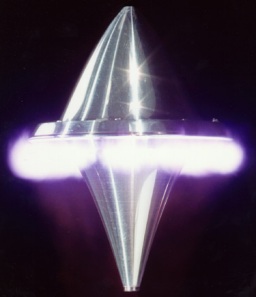
- Omega Seamaster Professional Divers's wrist watch contains a laser used to escape from the villain's private train which is about to explode.
- Miniature laser contained in a mountain climber's piton gun is used to burn through a steel doorway to a secret russian bio weapons facility concealed inside a hydroelectric dam.
- From a space shuttle, James Bond uses a laser to destroy several pods before they reenter earth's atmosphere and destroy humanity with lethal nerve gas.
- In the temporary 'Q' laboratories in Rio de Janeiro, a laser rifle
is tested on rubber dummy and the head seems to be melting.
The rifles are later used by a squad of 'space-marines'
powered by MMU's (Manned Maneuvering Units).
 James Bond is about to be sliced in half by Auric Goldfinger's
laser.
James Bond is about to be sliced in half by Auric Goldfinger's
laser.Bond: "Do you expect me to talk ?"
Goldfinger: "No Mr. Bond, I expect you to die !"
- High power ruby laser used by Goldfinger to process metals (how?)
Goldfinger attempts to use it for more sadistic purposes on a helpless James Bond.
- Diamonds are the lasing material used for constructing a satellite based laser weapon used by Specter to extort money from the nuclear powers. The diamonds are part of a parabolic antenna, which is curious because normally this is used to focus radiation. If the diamonds were lasing they would have to be optically pumped; electrical pumping is not an option because natural diamond is one of the best electrical insulators around. Also they would have to be phase locked otherwise the beam would quickly degrade due to incoherent addition of multiple beams with random relative phases. One point that is overlooked by the author(s) is how the laser makes it trough atmospheric turbulence without distortion ?
- Russian whiz kid formerly of the KGB constructs high powered laser in a wrist watch. Bond uses it to cut off his steel wrist shackles holding his prisoner in a dungeon.
- Laser in the wheel of an Astin Martin Volante. Bond uses it to causes a separation of the undercarriage of a pursuing police car.





